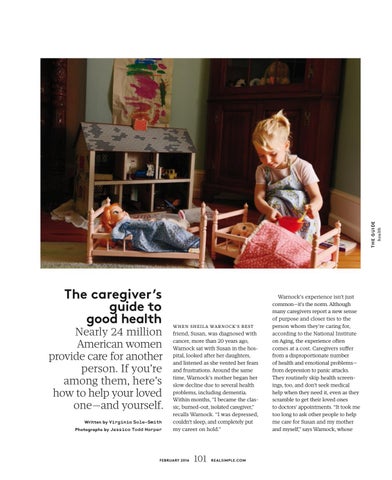THE GUIDE health
The caregiver’s guide to good health Nearly 24 million American women provide care for another person. If you’re among them, here’s how to help your loved one—and yourself. Written by Virginia Sole-Smith Photographs by Jessica Todd Harper
W H E N S H E I L A WA R N O C K ’ S B E S T
friend, Susan, was diagnosed with cancer, more than 20 years ago, Warnock sat with Susan in the hospital, looked after her daughters, and listened as she vented her fears and frustrations. Around the same time, Warnock’s mother began her slow decline due to several health problems, including dementia. Within months, “I became the classic, burned-out, isolated caregiver,” recalls Warnock. “I was depressed, couldn’t sleep, and completely put my career on hold.”
FEBRUARY 2016
101
REALSIMPLE.COM
Warnock’s experience isn’t just common—it’s the norm. Although many caregivers report a new sense of purpose and closer ties to the person whom they’re caring for, according to the National Institute on Aging, the experience often comes at a cost. Caregivers suffer from a disproportionate number of health and emotional problems— from depression to panic attacks. They routinely skip health screenings, too, and don’t seek medical help when they need it, even as they scramble to get their loved ones to doctors’ appointments. “It took me too long to ask other people to help me care for Susan and my mother and myself,” says Warnock, whose

























